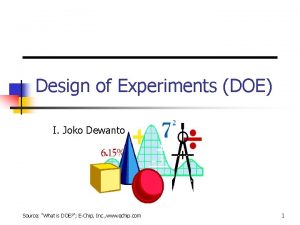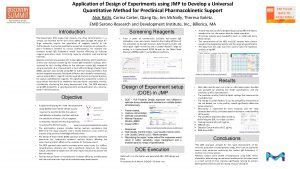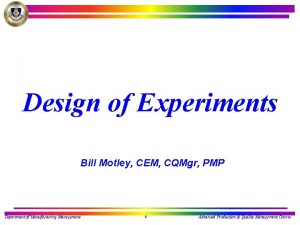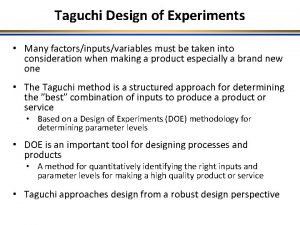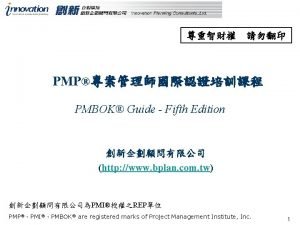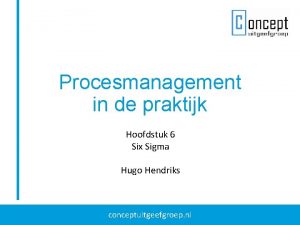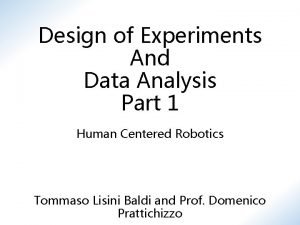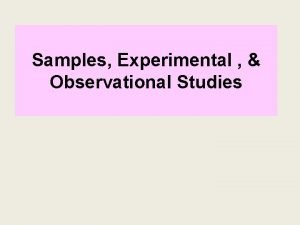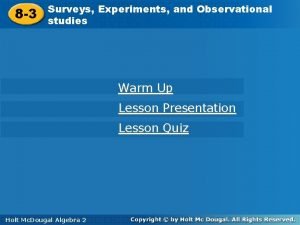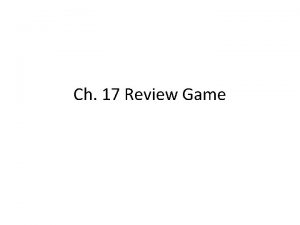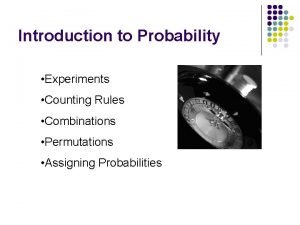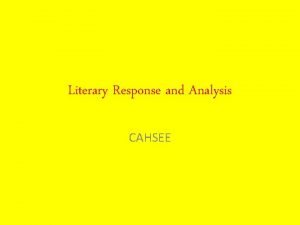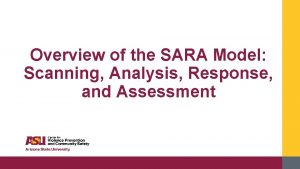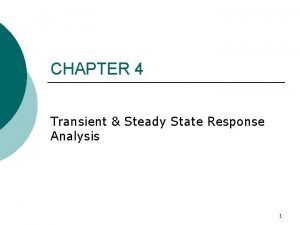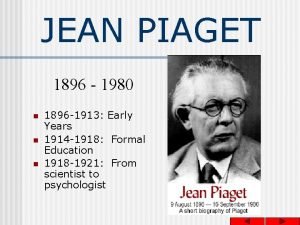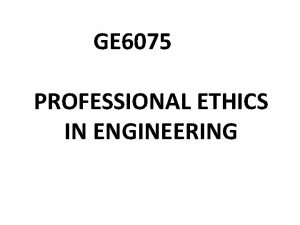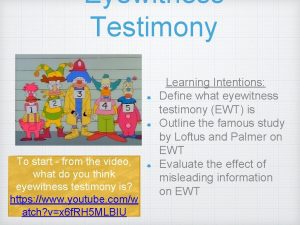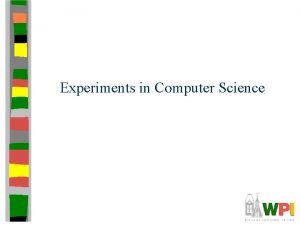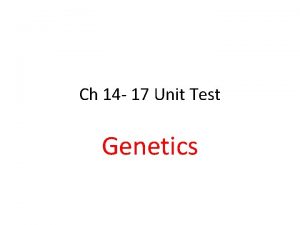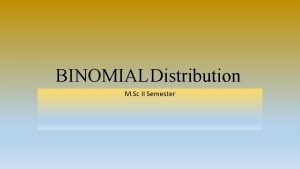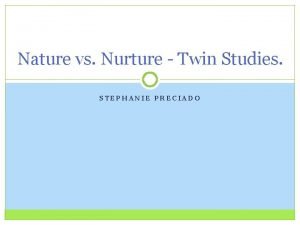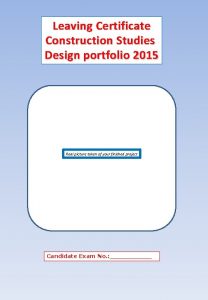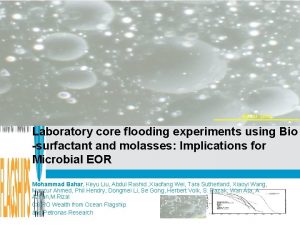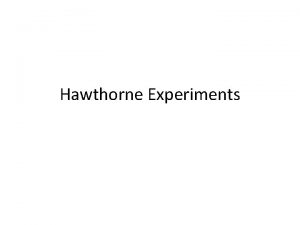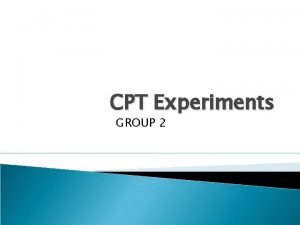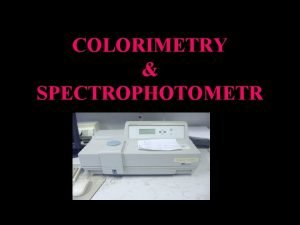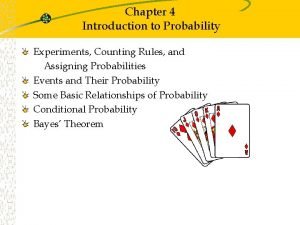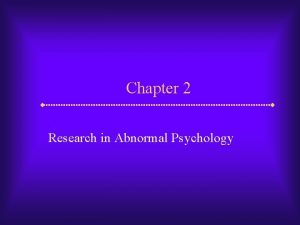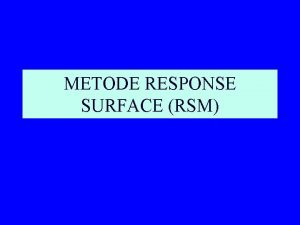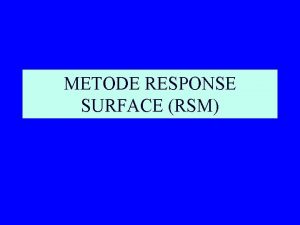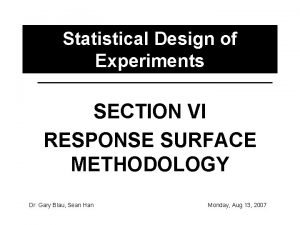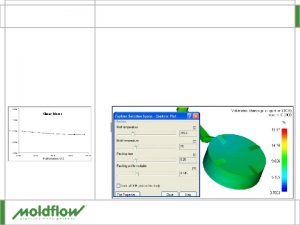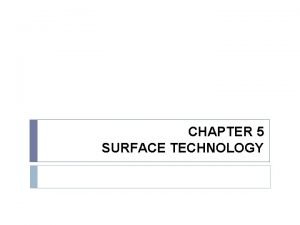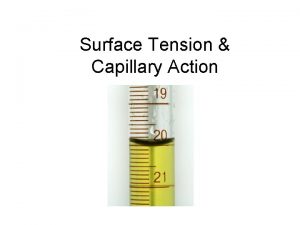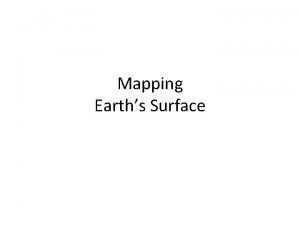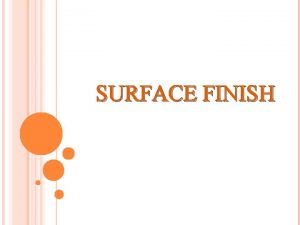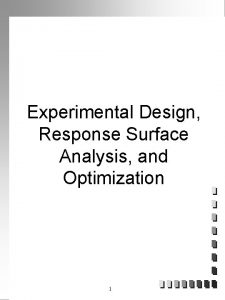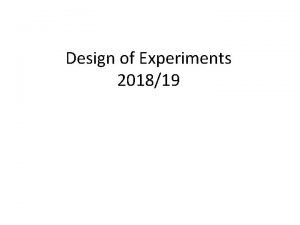Design and Analysis of MultiFactored Experiments Response Surface






















































- Slides: 54

Design and Analysis of Multi-Factored Experiments Response Surface Methodology L. M. Lye DOE Course 1

Introduction to Response Surface Methodology (RSM) • Best and most comprehensive reference: – R. H. Myers and D. C. Montgomery (2002): Response Surface Methodology: Process and Product Optimization Using Designed Experiments, John Wiley and Sons. • Best software: – Design-Expert Version 6 - Statease Inc. – Available at www. statease. com L. M. Lye DOE Course 2

RSM: Introduction • Primary focus of previous discussions is factor screening – Two-level factorials, fractional factorials are widely used • RSM dates from the 1950 s (Box and Wilson, 1951) • Early applications in the chemical industry • Currently RSM is widely used in quality improvement, product design, uncertainty analysis, etc. L. M. Lye DOE Course 3

Objective of RSM • RSM is a collection of mathematical and statistical techniques that are useful for modeling and analysis in applications where a response of interest is influenced by several variables and the objective is to optimize the response. • Optimize maximize, minimize, or getting to a target. • Or, where a nonlinear is warranted when there is significant curvature in the response surface. L. M. Lye DOE Course 4

Uses of RSM • To determine the factor levels that will simultaneously satisfy a set of desired specification (e. g. model calibration) • To determine the optimum combination of factors that yield a desired response and describes the response near the optimum • To determine how a specific response is affected by changes in the level of the factors over the specified levels of interest L. M. Lye DOE Course 5

Uses of RSM (cont) · To achieve a quantitative understanding of the system behavior over the region tested · To find conditions for process stability = insensitive spot (robust condition) · To replace a more complex model with a much simpler second-order regression model for use within a limited range L. M. Lye DOE Course 6

Example Suppose that an engineer wishes to find the levels of temperature (x 1) and feed concentration (x 2) that maximize the yield (y) of a process. The yield is a function of the levels of x 1 and x 2, by an equation: Y = f (x 1, x 2) + e If we denote the expected response by E(Y) = f (x 1, x 2) = L. M. Lye DOE Course 7

then the surface represented by: = f (x 1, x 2) is called a response surface. The response surface maybe represented graphically using a contour plot and/or a 3 -D plot. In the contour plot, lines of constant response (y) are drawn in the x 1, x 2, plane. L. M. Lye DOE Course 8

L. M. Lye DOE Course 9

These plots are of course possible only when we have two factors. With more than two factors, the optimal yield has to be obtained using numerical optimization methods. In most RSM problems, the form of the relationship between the response and the independent variables is unknown. Thus, the first step in RSM is to find a suitable approximation for the true relationship between Y and the X’s. L. M. Lye DOE Course 10

If the response is well modeled by a linear function of the independent variables, then the approximating function is the first-order model (linear): Y = b 0 + b 1 x 1 + b 2 x 2 + … + bk xk + e If there is curvature in the system, then a polynomial of higher degree must be used, such as the secondorder model: Y = b 0 + Sbi xi + Sbii x 2 i + SSbij xi xj + e This model has linear + interaction + quadratic terms. L. M. Lye DOE Course 11

• Many RSM problems utilize one or both of these approximating polynomials. The response surface analysis is then done in terms of the fitted surface. The 2 nd order model is nearly always adequate if the surface is “smooth”. • If the fitted surface is an adequate approximation (high R 2) of the true response function, then analysis of the fitted surface will be approximately equivalent to analysis of the actual system (within bounds). L. M. Lye DOE Course 12

Sequential Nature of RSM • RSM is a sequential procedure. That is, it done in small steps to locate the optimum point. • The analogy of climbing a hill is appropriate here (especially if it is a very foggy day)! • When we are far from the optimum (far from the peak) there is little curvature in the system (slight slope only), then first-order model will be appropriate. L. M. Lye DOE Course 13

Sequential Nature of RSM (continue) • The objective is to lead the experimenter rapidly and efficiently to the general vicinity of the optimum. • Once the region of the optimum has been found, a more elaborate model such a second-order model may be employed, and an analysis performed to locate the optimum. L. M. Lye DOE Course 14

L. M. Lye DOE Course 15

• The eventual objective of RSM is to determine the optimum operating conditions for the system or to determine a region of the factor space in which operating specifications are satisfied. • The word “Optimum” in RSM is used in a special sense. The “hill climbing” procedures of RSM guarantee convergence to a local optimum only. • In terms of experimental designs, when we are far from optimum, a simple 2 k factorial experiment would allow us to fit a first-order model. As we get nearer to the peak, we can check for curvature by adding center-points to the 2 k factorial. L. M. Lye DOE Course 16

• If curvature is significant, we may now be in the vicinity of the peak and we use a more elaborate design (e. g. a CCD) to fit a second-order model to “capture” the optimum. L. M. Lye DOE Course 17

Method of Steepest Ascent • The method of steepest ascent is a procedure for moving sequentially along the path of steepest ascent (PSA), that is, in the direction of the maximum increase in the response. If minimization is desired, then we are talking about the method of steepest descent. • For a first-order model, the contours of the response surface is a series of parallel lines. The direction of steepest ascent is the direction in which the response y increases most rapidly. This direction is normal (perpendicular) to the fitted response surface contours. L. M. Lye DOE Course 18

First-order response and PSA L. M. Lye DOE Course 19

Path of Steepest Ascent (PSA) • The PSA is usually the line through the center of the region of interest and normal to the fitted surface contours. • The steps along the path are proportional to the regression coefficients {bi}. The actual step size would depend on the experimenter’s knowledge of the process or other practical considerations. L. M. Lye DOE Course 20

For example, consider the first-order model: y = 40. 00 + 0. 775 x 1 + 0. 325 x 2 For steepest ascent, we move 0. 775 unit in the x 1 direction for every 0. 325 unit in the x 2 direction. Thus the PSA passes through the center (0, 0) and has a slope of 0. 375/0. 775. L. M. Lye DOE Course 21

If say 1 unit of x 1 is actually equal to 5 minutes in actual units, and 1 unit of x 2 is actually equal to 5 F, the PSA are Dx 1 = 1. 00 and Dx 2 = (0. 375/0. 775) Dx 2 = 0. 42 = 2. 1 F. Therefore, you will move along the PSA by increasing time by 5 minutes and temperature by 2 F. An actual observation on yield will be determined at each point. L. M. Lye DOE Course 22

• Experiments are then conducted along the PSA until no further increase in the response is observed. • Then a new first-order model may be fit, a new direction of steepest ascent determined, and further experiments conducted in that direction until the experimenter feels that the process is near the optimum (peak of hill is within grasp!). L. M. Lye DOE Course 23

Yield vs steps along the PSA L. M. Lye DOE Course 24

• The steepest ascent would terminate after about 10 steps with an observed response of about 80%. Now we move on to the next step. • Fit another first-order model with a new center (where step 10 is) and check whethere is a new PSA. • Repeat until peak is near. • See flowchart on the next slide. L. M. Lye DOE Course 25

Flowchart for RSM L. M. Lye DOE Course 26

Steps in RSM • Fit linear model/planar models using two-level factorials • From results, determine PSA (Descent) • Move along path until no improvement occurs • Repeat steps 1 and 2 until near optimal (change of direction is possible) • Fit quadratic model near optimal in order to determine curvature and find peak. This phase is often called “method of local exploration” • Run confirmatory tests L. M. Lye DOE Course 27

Steps in RSM L. M. Lye DOE Course 28

• With well-behaved functions with a single peak or valley, the above procedure works very well. It becomes more difficult to use RSM or any other optimization routine when the surface has many peaks, ridges, and valleys. Response surface with many peaks and valleys L. M. Lye DOE Course 29

Multiple Objectives • With more than 2 factors, it is more difficult to determine where the optimal is. There may be several possible “optimal” points and not all are desirable. Whatever the final choice of optimal factor levels, common sense and process knowledge must be your guide. • It is also possible to have more than one response variable with different objectives (sometimes conflicting). For these cases, a weighting system may be used to for the various objectives. L. M. Lye DOE Course 30

Methods of Local Exploration • Method of steepest ascent, in addition to fitting first-order model, must provide additional information that will eventually identify when the first-order model is no longer valid. • This information can come only from additional degrees of freedom which are used to measure “lack of fit” in some way. L. M. Lye DOE Course 31

Consider the 2 nd order model: Y = b 0 + b 1 x 1 + b 2 x 2 + … + bk xk + b 11 x 12 + b 22 x 22 + … + bkk xk 2 + b 12 x 1 x 2 + … + b 1 k x 1 xk + … + b 23 x 2 x 3 + … + bk-1, k xk-1 xk + e ------- EQN (1) To be able to fit a 2 nd order model like EQN (1), there must be least three levels and enough data points. L. M. Lye DOE Course 32

Designs for fitting 2 nd order models • Two very useful and popular experimental designs that allow a 2 nd order model to be fit are the: · Central Composite Design (CCD) · Box-Behnken Design (BBD) · Both designs are built up from simple factorial or fractional factorial designs. L. M. Lye DOE Course 33

3 -D views of CCD and BBD L. M. Lye DOE Course 34

Central Composite Design (CCD) · Each factor varies over five levels · Typically smaller than Box-Behnken designs · Built upon two-level factorials or fractional factorials of Resolution V or greater · Can be done in stages factorial + centerpoints + axial points · Rotatable L. M. Lye DOE Course 35

General Structure of CCD • 2 k Factorial + 2 k Star or axial points + nc Centerpoints • The factorial part can be a fractional factorial as long as it is of Resolution V or greater so that the 2 factor interaction terms are not aliased with other 2 factor interaction terms. • The “star” or “axial” points in conjunction with the factorial and centerpoints allows the quadratic terms (bii) to be estimated. L. M. Lye DOE Course 36

Axial points are points on the coordinate axes at distances “a” from the design center; that is, with coordinates: For 3 factors, we have 2 k = 6 axial points like so: (+a, 0, 0), (-a, 0, 0), (0, +a, 0), (0, -a, 0), (0, 0, +a), (0, 0, -a) The “a” value is usually chosen so that the CCD is rotatable. At least one point must be at the design center (0, 0, 0). Usually more than one to get an estimate of “pure error”. See earlier 3 -D figure. If the “a” value is 1. 0, then we have a face-centered CCD Not rotatable but easier to work with. L. M. Lye DOE Course 37

A 3 -Factor CCD with 1 centerpoint L. M. Lye DOE Course 38

Values of a for CCD to be rotatable The a value is calculated as the 4 th root of 2 k. For a rotatable design the variance of the predicted response is constant at all points that are equidistant from the center of the design L. M. Lye DOE Course 39

BOX-BEHNKEN DESIGNS (BBD) · Each factor is varied over three levels (within low and high value) · Alternative to central composite designs which requires 5 levels · BBD not always rotatable · Combinations of 2 -level factorial designs form the BBD. L. M. Lye DOE Course 40

A 3 -Factor BBD with 1 centerpoint L. M. Lye DOE Course 41

Comparison of CCD and BBD With one centerpoint, for k = 3, CCD requires 15 runs; BBD requires 13 runs k = 4, CCD requires 25 runs; BBD also requires 25 runs k = 5, CCD requires 43 runs; BBD requires 41 runs but, for CCD we can run a 25 -1 FFD with Resolution V. Hence we need only 27 runs. In general CCD is preferred over BBD. L. M. Lye DOE Course 42

Analysis of the fitted response surface • The fitted response surface can take on many shapes. • For 2 or less dimensions, we can plot the response against the factor(s) and graphically determine where the optimal response is. • We can also tell from the contour plots or 3 -D plots whether we have a maximum, minimum, or a saddle point. These points are stationary points. L. M. Lye DOE Course 43

Types of stationary points a) Maximum point; b) Minimum point; c) Saddle point L. M. Lye DOE Course 44

With more than 2 factors • For more than 2 factors, we need to use numerical methods to tell what kind of stationary point we have. • In some cases, even this fails. • The levels of the k factors at which the response is optimal can be determined for the unconstrained case by simple calculus. L. M. Lye DOE Course 45

When k=1 Consider the 2 nd order prediction model with k =1: Provided that b 2 is not zero, the optimum response is obtained by: Giving: L. M. Lye DOE Course 46

For k > 1 In the case of k > 1, we can write the 2 nd order equation y = b 0 + b 1 x 1 + b 2 x 2 + … + bk xk + b 11 x 12 + b 22 x 22 + … + bkk xk 2 + b 12 x 1 x 2 + … + b 1 k x 1 xk + … + b 23 x 2 x 3 + … + bk-1, k xk-1 xk in a more convenient matrix form as: y = b 0 + x’ b + x’ B x L. M. Lye DOE Course 47

Where: L. M. Lye DOE Course 48

Provided that matrix B is not singular, the 2 nd order model has a stationary point (i. e. , a point at which first partial derivatives with respect to x 1, x 2, …, xk are all 0) given by: Depending on the nature of B, the stationary point will be either a minimum, a maximum, or a saddle point of the fitted surface. Moving away from a saddle point in some directions produces an increase in the response, while moving away in other directions produces a decrease in the response. L. M. Lye DOE Course 49

Characterization of the stationary point If B is positive definite all eigenvalues are positive minimum pt. If B is negative definite all eigenvalues are negative maximum pt. If B is indefinite eigenvalues are positive and negative saddle pt. Eigenvalues of matrix B can be obtained using MATLAB L. M. Lye DOE Course 50

Be aware that the xo obtained are random variables and have associated uncertainty with them as are the eigenvalues and matrix B. There will be situations when an unconstrained optimum will not be useful (when there is a saddle point). We need to consider a constraint that forces us to stay within the experimental region. The procedure that has been developed for this is called ridge analysis (see Myers and Montgomery). Need to use Lagrange multipliers here for the optimization. L. M. Lye DOE Course 51

There also other methods for solving optimization problems constrained or unconstrained that do not require the taking of partial derivatives Direct Optimization procedures. E. g. Nelder. Mead simplex search procedure, or by simulation. RSM are now done mainly by software except for simple cases. One of the best on the market is DESIGN-EXPERT by Statease Inc. L. M. Lye DOE Course 52

Other Aspects of Response Surface Methodology • Robust parameter design and process robustness studies – Find levels of controllable variables that optimize mean response and minimize variability in the response transmitted from “noise” variables – Original approaches due to Taguchi (1980 s) – Modern approach based on RSM • Experiments with mixtures – Special type of RSM problem – Design factors are components (ingredients) of a mixture – Response depends only on the proportions – Many applications in product formulation L. M. Lye DOE Course 53

Golfing Challenge – 5 holes • Conduct an experiment using the golfing toy and obtain a prediction equation for the toy for use in a 5 -hole golf championship to be played using the toy in the Faculty Lounge on Nov 25 th and 27 th. • [Hint: Use a face-centered CCD RS design or BBD RS design] • Team with the least total number of strokes over 5 holes wins 10 extra marks and bragging rights! • You must also summit a report of your experimental design. L. M. Lye DOE Course 54
 Nn torrent
Nn torrent Design of experiments doe
Design of experiments doe Jmp doe analysis
Jmp doe analysis Full factorial design
Full factorial design Design of experiments quality management pmp
Design of experiments quality management pmp Design of experiments presentation
Design of experiments presentation Worked out
Worked out Pmp stakeholder engagement plan
Pmp stakeholder engagement plan Design of experiments
Design of experiments Six sigma betekenis
Six sigma betekenis Design of experiments
Design of experiments Natural and forced response
Natural and forced response Natural response circuit
Natural response circuit Primary immune response and secondary immune response
Primary immune response and secondary immune response Design of output
Design of output Volume and surface area of cone
Volume and surface area of cone What is the surface area of the prism in square inches
What is the surface area of the prism in square inches Biased and unbiased samples
Biased and unbiased samples What is survey experiment or observation?
What is survey experiment or observation? 2k factorial experiments and fractions
2k factorial experiments and fractions Chapter 13 experiments and observational studies
Chapter 13 experiments and observational studies Miller and urey's experiments attempted to demonstrate
Miller and urey's experiments attempted to demonstrate Counting rule for multiple-step experiment
Counting rule for multiple-step experiment Experiments on animals pros and cons
Experiments on animals pros and cons User interface design in system analysis and design
User interface design in system analysis and design Dialogue design
Dialogue design Tools for structured analysis
Tools for structured analysis Fact finding techniques observation
Fact finding techniques observation System analysis and design project proposal example
System analysis and design project proposal example Spin coat
Spin coat Simile definition
Simile definition Sara model feedback
Sara model feedback Steady state response formula
Steady state response formula Http://earthobservatory.nasa.gov/experiments/biome/
Http://earthobservatory.nasa.gov/experiments/biome/ M&m experiments with scientific method
M&m experiments with scientific method Jean piaget 1896-1980
Jean piaget 1896-1980 Balanced outlook on law
Balanced outlook on law Science experiments for highschool
Science experiments for highschool Eyewitness testimony video experiments
Eyewitness testimony video experiments Computer science experiments
Computer science experiments Czech experiments
Czech experiments Monomer of dna
Monomer of dna In his transformation experiments what did griffith observe
In his transformation experiments what did griffith observe Merit and demerit of standard deviation
Merit and demerit of standard deviation Examples of binomial experiments
Examples of binomial experiments Virtual lab for computer organization and architecture
Virtual lab for computer organization and architecture Dirk brings his family tree to class
Dirk brings his family tree to class Barbara herbert and daphne goodship
Barbara herbert and daphne goodship Leaving cert construction project portfolio sample
Leaving cert construction project portfolio sample Core flooding experiment
Core flooding experiment Mica splitting study
Mica splitting study Experiments in goodness
Experiments in goodness How colorimeter works
How colorimeter works Counting rule for multiple-step experiments
Counting rule for multiple-step experiments Abnormal psychology experiments
Abnormal psychology experiments

